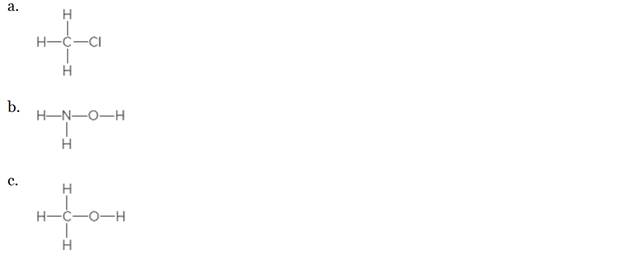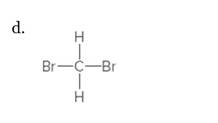
General, Organic, & Biological Chemistry
3rd Edition
ISBN: 9780073511245
Author: Janice Gorzynski Smith Dr.
Publisher: McGraw-Hill Education
expand_more
expand_more
format_list_bulleted
Concept explainers
Textbook Question
Chapter 4.1, Problem 4.4P
Fill in the lone pairs on each atom to give every main group element except hydrogen an octet.


Expert Solution & Answer
Want to see the full answer?
Check out a sample textbook solution
Students have asked these similar questions
Problems
1.
Acids (11) and (12) were both made by Grignard
addition to CO2 rather than by cyanide displacement
(p T 80).
Why?
(11)
-CO2H
MeO-
(12)
CO,H
2.
Aldehyde (8) was needed for a butenolide synthesis.
How would (8) be made?
CHO
Show work with explanation needed. don't give Ai generated solution. don't copy the answer anywhere
Chapter 4 Solutions
General, Organic, & Biological Chemistry
Ch. 4.1 - Use electron-dot symbols to show how a hydrogen...Ch. 4.1 - Use electron-dot symbols to show how two chlorine...Ch. 4.1 - How many covalent bonds are predicted for each...Ch. 4.1 - Fill in the lone pairs on each atom to give every...Ch. 4.1 - Prob. 4.5PCh. 4.1 - Draw a Lewis structure for each covalent molecule....Ch. 4.1 - Draw a Lewis structure for dimethyl ether (C2H6O)...Ch. 4.2 - Prob. 4.8PCh. 4.2 - Prob. 4.9PCh. 4.2 - Prob. 4.10P
Ch. 4.3 - Prob. 4.11PCh. 4.3 - Prob. 4.12PCh. 4.4 - Prob. 4.13PCh. 4.4 - Draw resonance structures for each polyatomic...Ch. 4.4 - Nitrous oxide, N2O, is a sweet-smelling gas...Ch. 4.5 - Name each compound: (a) CS2; (b) SO2; (c) PCl5;...Ch. 4.5 - Prob. 4.17PCh. 4.5 - What is the shape around the indicated atom in...Ch. 4.6 - NaNH2, sodium amid, is a salt that contains a...Ch. 4.6 - Prob. 4.20PCh. 4.7 - Using the trends in the periodic table, rank the...Ch. 4.7 - Use electronegativity values to classify the...Ch. 4.7 - Prob. 4.23PCh. 4.8 - Prob. 4.24PCh. 4.9 - Prob. 4.25PCh. 4.9 - Prob. 4.26PCh. 4 - For each pair of compounds, classify the bonding...Ch. 4 - For each pair of compounds, classify the bonding...Ch. 4 - Prob. 4.29PCh. 4 - How many bonds and lone pairs are typically...Ch. 4 - Prob. 4.31PCh. 4 - Fill in the lone pairs needed to give the main...Ch. 4 - Prob. 4.33PCh. 4 - Convert the 3-D model of the general anesthetic...Ch. 4 - Draw a valid Lewis structure for each molecule. Hl...Ch. 4 - Draw a valid Lewis structure for each molecule....Ch. 4 - Prob. 4.37PCh. 4 - Prob. 4.38PCh. 4 - Draw a valid Lewis structure for...Ch. 4 - Draw a valid Lewis structure for phosgene, CCl2O ,...Ch. 4 - Draw a valid Lewis structure for each ion: (a)...Ch. 4 - Draw a valid Lewis structure for each ion: (a)...Ch. 4 - Keeping in mind that some elements violate the...Ch. 4 - Keeping in mind that some elements violate the...Ch. 4 - Prob. 4.45PCh. 4 - Prob. 4.46PCh. 4 - Prob. 4.47PCh. 4 - Prob. 4.48PCh. 4 - Prob. 4.49PCh. 4 - Label each pair of compounds are resonance...Ch. 4 - Prob. 4.51PCh. 4 - Draw three resonance structures for the nitrate...Ch. 4 - Name each covalent compound. PBr3 SO3 NCl3 P2S5Ch. 4 - Name each covalent compound. SF6 CBr4 N2O P4O10Ch. 4 - Prob. 4.55PCh. 4 - Prob. 4.56PCh. 4 - Add lone pairs where needed to give octets and...Ch. 4 - Add lone pairs where needed to give octets and...Ch. 4 - Prob. 4.59PCh. 4 - Match each compound with one of the molecular...Ch. 4 - Prob. 4.61PCh. 4 - Add lone pairs where needed to give octets and...Ch. 4 - Prob. 4.63PCh. 4 - Considering each of the given ball-and stick...Ch. 4 - Prob. 4.65PCh. 4 - Prob. 4.66PCh. 4 - Prob. 4.67PCh. 4 - Predict the bond angles around the indicated atoms...Ch. 4 - Prob. 4.69PCh. 4 - Prob. 4.70PCh. 4 - Rank the atoms in each group in order of...Ch. 4 - Prob. 4.72PCh. 4 - Prob. 4.73PCh. 4 - Using electronegativity values, classify the bond...Ch. 4 - Label the bond formed between carbon and each of...Ch. 4 - Label the bond formed between fluroine and each of...Ch. 4 - Which bond in each pair is more polar-that is, has...Ch. 4 - Which bond in each pair is more polar-that is, has...Ch. 4 - Prob. 4.79PCh. 4 - Prob. 4.80PCh. 4 - Label the polar bonds and then decide if each...Ch. 4 - Label the polar bonds and then decide if each...Ch. 4 - Prob. 4.83PCh. 4 - Explain why H2O is a polar molecule but H2S is...Ch. 4 - Convert each ball-and-stick model to a Lewis...Ch. 4 - Convert each ball-and-stick model to a Lewis...Ch. 4 - Answer the following questions about the molecule...Ch. 4 - Answer the following question about the molecule...Ch. 4 - Prob. 4.89PCh. 4 - Lactic acid gives sour milk its distinctive taste....Ch. 4 - Prob. 4.91PCh. 4 - Prob. 4.92PCh. 4 - Prob. 4.93PCh. 4 - Prob. 4.94PCh. 4 - Isobutyl cyanoacrylate is used in medical glues to...Ch. 4 - Prob. 4.96PCh. 4 - Cyclopropane is a stable compound that contains...Ch. 4 - Prob. 4.98CPCh. 4 - Prob. 4.99CPCh. 4 - Prob. 4.100CP
Additional Science Textbook Solutions
Find more solutions based on key concepts
What process causes the Mediterranean intermediate Water MIW to become more dense than water in the adjacent At...
Applications and Investigations in Earth Science (9th Edition)
Give the IUPAC name for each compound.
Organic Chemistry
Some people consider Pasteur or Koch to be the Father of Microbiology, rather than Leeuwenhoek. Why might they ...
Microbiology with Diseases by Body System (5th Edition)
How could you separate a mixture of the following compounds? The reagents available to you are water, either, 1...
Organic Chemistry (8th Edition)
45. Calculate the mass of nitrogen dissolved at room temperature in an 80.0-L home aquarium. Assume a total pre...
Chemistry: Structure and Properties (2nd Edition)
Knowledge Booster
Learn more about
Need a deep-dive on the concept behind this application? Look no further. Learn more about this topic, chemistry and related others by exploring similar questions and additional content below.Similar questions
- Show work. don't give Ai generated solution. Don't copy the answer anywherearrow_forward6. Consider the following exothermic reaction below. 2Cu2+(aq) +41 (aq)2Cul(s) + 12(aq) a. If Cul is added, there will be a shift left/shift right/no shift (circle one). b. If Cu2+ is added, there will be a shift left/shift right/no shift (circle one). c. If a solution of AgNO3 is added, there will be a shift left/shift right/no shift (circle one). d. If the solvent hexane (C6H14) is added, there will be a shift left/shift right/no shift (circle one). Hint: one of the reaction species is more soluble in hexane than in water. e. If the reaction is cooled, there will be a shift left/shift right/no shift (circle one). f. Which of the changes above will change the equilibrium constant, K?arrow_forwardShow work. don't give Aiarrow_forward
- Show work with explanation needed. don't give Ai generated solutionarrow_forwardShow work with explanation needed. Don't give Ai generated solutionarrow_forward7. Calculate the following for a 1.50 M Ca(OH)2 solution. a. The concentration of hydroxide, [OH-] b. The concentration of hydronium, [H3O+] c. The pOH d. The pHarrow_forward
- A first order reaction is 46.0% complete at the end of 59.0 minutes. What is the value of k? What is the half-life for this reaction? HOW DO WE GET THERE? The integrated rate law will be used to determine the value of k. In [A] [A]。 = = -kt What is the value of [A] [A]。 when the reaction is 46.0% complete?arrow_forward3. Provide the missing compounds or reagents. 1. H,NNH КОН 4 EN MN. 1. HBUCK = 8 хно Panely prowseful kanti-chuprccant fad, winddively, can lead to the crading of deduc din-willed, tica, The that chemooices in redimi Грин. " like (for alongan Ridovi MN نيا . 2. Cl -BuO 1. NUH 2.A A -BuOK THE CF,00,H Ex 5)arrow_forward2. Write a complete mechanism for the reaction shown below. NaOCH LOCH₁ O₂N NO2 CH₂OH, 20 °C O₂N NO2arrow_forward
- 4. Propose a synthesis of the target molecules from the respective starting materials. a) b) LUCH C Br OHarrow_forwardThe following mechanism for the gas phase reaction of H2 and ICI that is consistent with the observed rate law is: step 1 step 2 slow: H2(g) +ICI(g) → HCl(g) + HI(g) fast: ICI(g) + HI(g) → HCl(g) + |2(g) (1) What is the equation for the overall reaction? Use the smallest integer coefficients possible. If a box is not needed, leave it blank. + → + (2) Which species acts as a catalyst? Enter formula. If none, leave box blank: (3) Which species acts as a reaction intermediate? Enter formula. If none, leave box blank: (4) Complete the rate law for the overall reaction that is consistent with this mechanism. (Use the form k[A][B]"..., where '1' is understood (so don't write it) for m, n etc.) Rate =arrow_forwardPlease correct answer and don't use hand rating and don't use Ai solutionarrow_forward
arrow_back_ios
SEE MORE QUESTIONS
arrow_forward_ios
Recommended textbooks for you
 Organic ChemistryChemistryISBN:9781305580350Author:William H. Brown, Brent L. Iverson, Eric Anslyn, Christopher S. FootePublisher:Cengage Learning
Organic ChemistryChemistryISBN:9781305580350Author:William H. Brown, Brent L. Iverson, Eric Anslyn, Christopher S. FootePublisher:Cengage Learning Chemistry: An Atoms First ApproachChemistryISBN:9781305079243Author:Steven S. Zumdahl, Susan A. ZumdahlPublisher:Cengage Learning
Chemistry: An Atoms First ApproachChemistryISBN:9781305079243Author:Steven S. Zumdahl, Susan A. ZumdahlPublisher:Cengage Learning Chemistry: The Molecular ScienceChemistryISBN:9781285199047Author:John W. Moore, Conrad L. StanitskiPublisher:Cengage Learning
Chemistry: The Molecular ScienceChemistryISBN:9781285199047Author:John W. Moore, Conrad L. StanitskiPublisher:Cengage Learning World of Chemistry, 3rd editionChemistryISBN:9781133109655Author:Steven S. Zumdahl, Susan L. Zumdahl, Donald J. DeCostePublisher:Brooks / Cole / Cengage Learning
World of Chemistry, 3rd editionChemistryISBN:9781133109655Author:Steven S. Zumdahl, Susan L. Zumdahl, Donald J. DeCostePublisher:Brooks / Cole / Cengage Learning Chemistry: Principles and PracticeChemistryISBN:9780534420123Author:Daniel L. Reger, Scott R. Goode, David W. Ball, Edward MercerPublisher:Cengage Learning
Chemistry: Principles and PracticeChemistryISBN:9780534420123Author:Daniel L. Reger, Scott R. Goode, David W. Ball, Edward MercerPublisher:Cengage Learning General, Organic, and Biological ChemistryChemistryISBN:9781285853918Author:H. Stephen StokerPublisher:Cengage Learning
General, Organic, and Biological ChemistryChemistryISBN:9781285853918Author:H. Stephen StokerPublisher:Cengage Learning

Organic Chemistry
Chemistry
ISBN:9781305580350
Author:William H. Brown, Brent L. Iverson, Eric Anslyn, Christopher S. Foote
Publisher:Cengage Learning

Chemistry: An Atoms First Approach
Chemistry
ISBN:9781305079243
Author:Steven S. Zumdahl, Susan A. Zumdahl
Publisher:Cengage Learning

Chemistry: The Molecular Science
Chemistry
ISBN:9781285199047
Author:John W. Moore, Conrad L. Stanitski
Publisher:Cengage Learning

World of Chemistry, 3rd edition
Chemistry
ISBN:9781133109655
Author:Steven S. Zumdahl, Susan L. Zumdahl, Donald J. DeCoste
Publisher:Brooks / Cole / Cengage Learning

Chemistry: Principles and Practice
Chemistry
ISBN:9780534420123
Author:Daniel L. Reger, Scott R. Goode, David W. Ball, Edward Mercer
Publisher:Cengage Learning

General, Organic, and Biological Chemistry
Chemistry
ISBN:9781285853918
Author:H. Stephen Stoker
Publisher:Cengage Learning
Stoichiometry - Chemistry for Massive Creatures: Crash Course Chemistry #6; Author: Crash Course;https://www.youtube.com/watch?v=UL1jmJaUkaQ;License: Standard YouTube License, CC-BY
Bonding (Ionic, Covalent & Metallic) - GCSE Chemistry; Author: Science Shorts;https://www.youtube.com/watch?v=p9MA6Od-zBA;License: Standard YouTube License, CC-BY
General Chemistry 1A. Lecture 12. Two Theories of Bonding.; Author: UCI Open;https://www.youtube.com/watch?v=dLTlL9Z1bh0;License: CC-BY